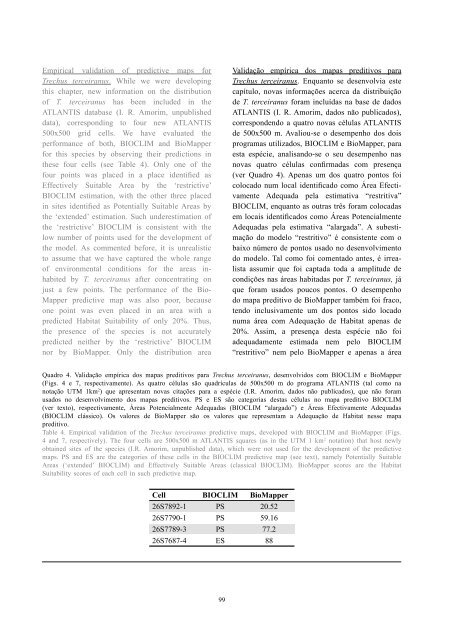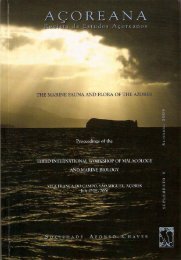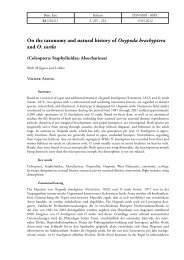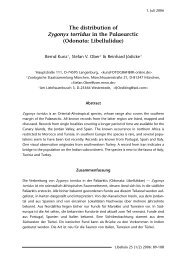(eds.) (2005). - Portal da Biodiversidade dos Açores - Universidade ...
(eds.) (2005). - Portal da Biodiversidade dos Açores - Universidade ...
(eds.) (2005). - Portal da Biodiversidade dos Açores - Universidade ...
Create successful ePaper yourself
Turn your PDF publications into a flip-book with our unique Google optimized e-Paper software.
Empirical vali<strong>da</strong>tion of predictive maps for<br />
Trechus terceiranus. While we were developing<br />
this chapter, new information on the distribution<br />
of T. terceiranus has been included in the<br />
ATLANTIS <strong>da</strong>tabase (I. R. Amorim, unpublished<br />
<strong>da</strong>ta), corresponding to four new ATLANTIS<br />
500x500 grid cells. We have evaluated the<br />
performance of both, BIOCLIM and BioMapper<br />
for this species by observing their predictions in<br />
these four cells (see Table 4). Only one of the<br />
four points was placed in a place identified as<br />
Effectively Suitable Area by the ‘restrictive’<br />
BIOCLIM estimation, with the other three placed<br />
in sites identified as Potentially Suitable Areas by<br />
the ‘extended’ estimation. Such underestimation of<br />
the ‘restrictive’ BIOCLIM is consistent with the<br />
low number of points used for the development of<br />
the model. As commented before, it is unrealistic<br />
to assume that we have captured the whole range<br />
of environmental conditions for the areas inhabited<br />
by T. terceiranus after concentrating on<br />
just a few points. The performance of the Bio-<br />
Mapper predictive map was also poor, because<br />
one point was even placed in an area with a<br />
predicted Habitat Suitability of only 20%. Thus,<br />
the presence of the species is not accurately<br />
predicted neither by the ‘restrictive’ BIOCLIM<br />
nor by BioMapper. Only the distribution area<br />
99<br />
Vali<strong>da</strong>ção empírica <strong>dos</strong> mapas preditivos para<br />
Trechus terceiranus. Enquanto se desenvolvia este<br />
capítulo, novas informações acerca <strong>da</strong> distribuição<br />
de T. terceiranus foram incluí<strong>da</strong>s na base de <strong>da</strong><strong>dos</strong><br />
ATLANTIS (I. R. Amorim, <strong>da</strong><strong>dos</strong> não publica<strong>dos</strong>),<br />
correspondendo a quatro novas células ATLANTIS<br />
de 500x500 m. Avaliou-se o desempenho <strong>dos</strong> dois<br />
programas utiliza<strong>dos</strong>, BIOCLIM e BioMapper, para<br />
esta espécie, analisando-se o seu desempenho nas<br />
novas quatro células confirma<strong>da</strong>s com presença<br />
(ver Quadro 4). Apenas um <strong>dos</strong> quatro pontos foi<br />
colocado num local identificado como Área Efectivamente<br />
Adequa<strong>da</strong> pela estimativa “restritiva”<br />
BIOCLIM, enquanto as outras três foram coloca<strong>da</strong>s<br />
em locais identifica<strong>dos</strong> como Áreas Potencialmente<br />
Adequa<strong>da</strong>s pela estimativa “alarga<strong>da</strong>”. A subestimação<br />
do modelo “restritivo” é consistente com o<br />
baixo número de pontos usado no desenvolvimento<br />
do modelo. Tal como foi comentado antes, é irrealista<br />
assumir que foi capta<strong>da</strong> to<strong>da</strong> a amplitude de<br />
condições nas áreas habita<strong>da</strong>s por T. terceiranus, já<br />
que foram usa<strong>dos</strong> poucos pontos. O desempenho<br />
do mapa preditivo de BioMapper também foi fraco,<br />
tendo inclusivamente um <strong>dos</strong> pontos sido locado<br />
numa área com Adequação de Habitat apenas de<br />
20%. Assim, a presença desta espécie não foi<br />
adequa<strong>da</strong>mente estima<strong>da</strong> nem pelo BIOCLIM<br />
“restritivo” nem pelo BioMapper e apenas a área<br />
Quadro 4. Vali<strong>da</strong>ção empírica <strong>dos</strong> mapas preditivos para Trechus terceiranus, desenvolvi<strong>dos</strong> com BIOCLIM e BioMapper<br />
(Figs. 4 e 7, respectivamente). As quatro células são quadrículas de 500x500 m do programa ATLANTIS (tal como na<br />
notação UTM 1km 2 ) que apresentam novas citações para a espécie (I.R. Amorim, <strong>da</strong><strong>dos</strong> não publica<strong>dos</strong>), que não foram<br />
usa<strong>dos</strong> no desenvolvimento <strong>dos</strong> mapas preditivos. PS e ES são categorias destas células no mapa preditivo BIOCLIM<br />
(ver texto), respectivamente, Áreas Potencialmente Adequa<strong>da</strong>s (BIOCLIM “alargado”) e Áreas Efectivamente Adequa<strong>da</strong>s<br />
(BIOCLIM clássico). Os valores de BioMapper são os valores que representam a Adequação de Habitat nesse mapa<br />
preditivo.<br />
Table 4. Empirical vali<strong>da</strong>tion of the Trechus terceiranus predictive maps, developed with BIOCLIM and BioMapper (Figs.<br />
4 and 7, respectively). The four cells are 500x500 m ATLANTIS squares (as in the UTM 1 km 2 notation) that host newly<br />
obtained sites of the species (I.R. Amorim, unpublished <strong>da</strong>ta), which were not used for the development of the predictive<br />
maps. PS and ES are the categories of these cells in the BIOCLIM predictive map (see text), namely Potentially Suitable<br />
Areas (‘extended’ BIOCLIM) and Effectively Suitable Areas (classical BIOCLIM). BioMapper scores are the Habitat<br />
Suitability scores of each cell in such predictive map.<br />
Cell BIOCLIM BioMapper<br />
26S7892-1 PS 20.52<br />
26S7790-1 PS 59.16<br />
26S7789-3 PS 77.2<br />
26S7687-4 ES 88

















